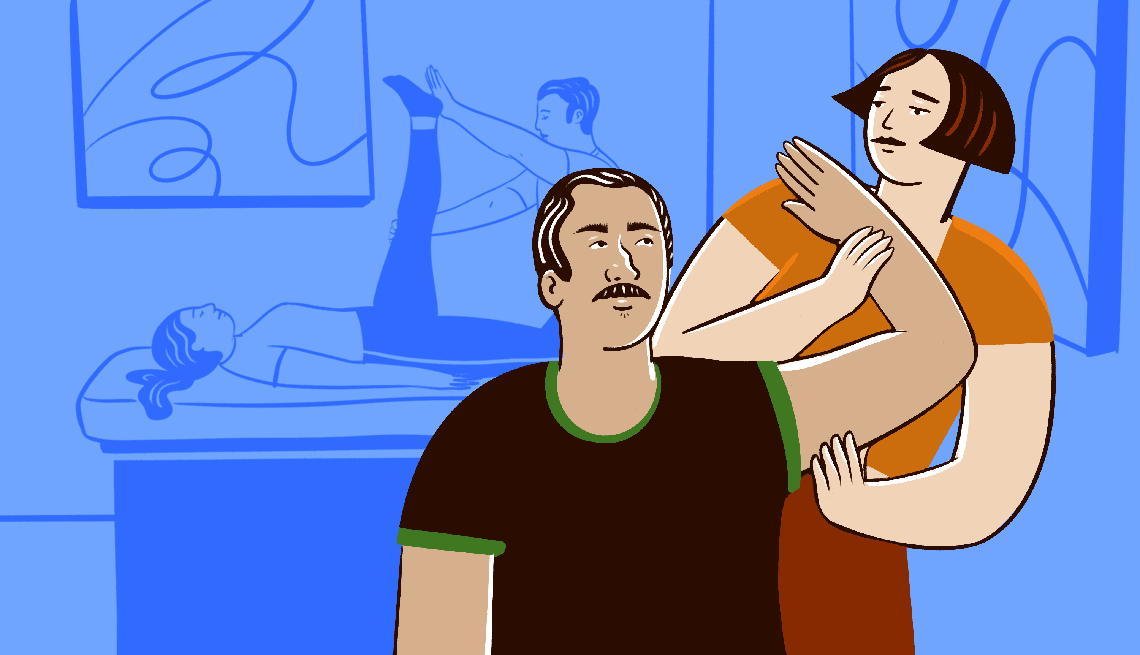AARP Hearing Center


Key takeaways
- My experience at StretchLab
- My experience at Stretch Zone
- Is a stretching studio right for you?
- Things to keep in mind
- Stretches you can do yourself
When you’re in your 30s and 40s, you may chase strength or endurance: heavier weights, longer runs. But after 50, what your body really craves might be something quieter but just as good for you: a solid stretch.
And we all should be stretching more. Studies show that stretching can improve multiple health conditions as we age, including joint pain (European Journal of Applied Physiology study, March 2025) and balance (International Journal of Health Sciences, 2016); it may even keep us walking longer (Geriatric Nursing, February 2025), which has its own health benefits.
As someone who is about to turn 50 and has been running for decades, practicing yoga and completed a few rounds of physical therapy, I have felt the benefits of stretching, but I know I should do more of it.
Recently, while leaving a yoga class in West Bloomfield, Michigan, I passed a StretchLab with a large sign advertising “Half off your first stretch!” Inside was a row of tables, a bit like a physical therapy office. Studios like this offer “assisted stretching,” meaning a practitioner would help stretch me, rather than me stretching myself.
One-on-one assisted stretching studios are popping up in shopping centers everywhere. StretchMed has about 40 locations across the U.S., with 37 listed as “opening soon,” while Stretch*d is only in New York and California. Two of the bigger chains, Stretch Zone and StretchLab, have hundreds of locations across the U.S., with more planned openings from both. The popularity is obvious, but would a stretching studio offer much beyond what I can do on my own? How do they decide which stretches to do? Is it similar to physical therapy? And does insurance cover it?
To learn more, I signed up for stretch sessions at Stretch Zone and StretchLab. Both involved one-on-one stretch sessions on a sturdy table or bench. At each session, the practitioner first asked me about the issues I’d been dealing with, how I felt and what I hoped to achieve during the session. Here’s how it went.
My experience at StretchLab


StretchLab is the largest assisted stretching brand, with over 500 studios in the U.S. and Canada and has been around since 2015. The cost varies by location, but for me it was $49 for the first 50-minute stretch and then $159 for three 25-minute sessions. StretchLab sessions are either 50 or 25 minutes long. I did two sessions and opted for 50 minutes each time.
At my first session, I was asked to do a few squats in front of a camera, and a program on a tablet highlighted my weak and tight areas based on my movements. It’s StretchLab’s proprietary technology, called MAPS (for Mobility, Activation, Posture, and Symmetry), and it uses 3-D imaging to identify imbalances in your movements and tailor stretches to your needs.
Along with the MAPS info, I also talked to my practitioner, Sara, about my typical pain points — my lower back and right hip. She said we’d work on those areas as well as others that were tight.
StretchLab practitioners, called “flexologists,” go through the company’s proprietary training program, which includes education on the muscular system and proper technique, says Kelsey Kerr, StretchLab’s director of training and experience. Flexologists must complete around 15 hours of online theory training on anatomy and stretching programs and pass a knowledge exam. They must also attend a two-day in-person training, which includes hands-on application of their online training, plus a performance exam.
To interview for a position, potential flexologists must have completed a four-year degree in a health and wellness field, or have an active certification in a related field, such as personal training, massage therapy, or yoga instruction. Each flexologist “has a foundation of knowledge in anatomy and body mechanics, giving them a deep understanding of how the body moves and functions,” says Natalie Beyer, a master flexologist at StretchLab in Los Angeles.


At StretchLab, both sessions took a full-body approach, and both included hamstring and hip stretches. The first session, with Sara, included some proprioceptive neuromuscular facilitation (PNF) stretching, which combines passive stretching with muscle contraction.
“[PNF is] like a hold-and-then-relax technique,” says Ben Yamuder, an exercise physiologist at Hospital for Special Surgery in New York City. With PNF, after you contract the muscle (or resist), you release. “Once you go to stretch again, you can actually get a little bit further,” Yamuder says.
So for a hamstring stretch, I lay on my back, and the practitioner lifted my leg up to around a 90-degree angle, holding it in place against her shoulder. I then pushed against her shoulder for a few seconds, then released my leg and moved it around before doing the same stretch again. It felt good, and my leg went further into the stretch the second time.
My second session, with a flexologist named Emily, began with her using a massage gun on my back and legs for a few minutes, which felt great and was used to prime the body before stretches. Then she focused on various assisted stretches for my hips, legs, and arms.





































































You Might Also Like
The Tyranny of Aging Well
Ideals rarely apply to everyday health
Interval Walking Is a Trend Worth Trying
The Japanese method is helping older adults build strength, boost energy and stay active
Insider Secrets on Integrative Medicine
Dr. Victoria Maizes shares 21 ways a holistic approach to health can heal what ails you